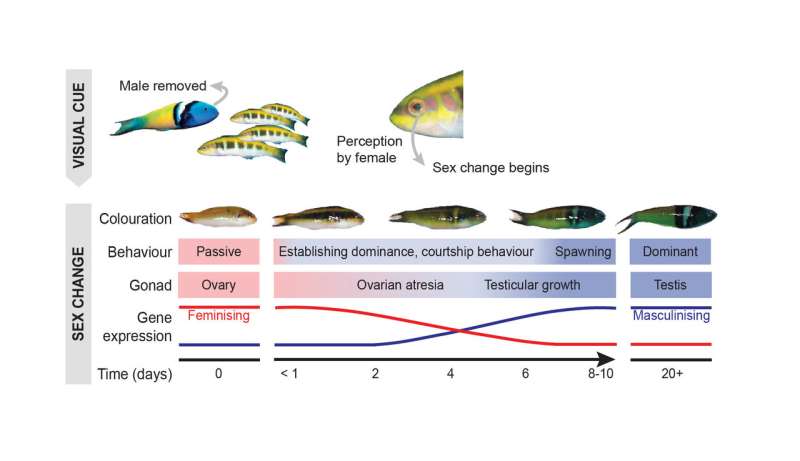Secrets of a sex-changing fish revealed

We may take it for granted that the sex of an animal is established at birth and doesn't change.
However, about 500 species of fish change sex in adulthood, often in response to environmental cues. How these fish change sex has, until now, been a mystery.
The secrets of fish that change sex have, for the first time, been revealed by an international collaboration led by New Zealand scientists and including La Trobe University geneticist and Prime Minister's Prize for Science winner 2017, Professor Jenny Graves. The findings were published today in the prestigious journal, Science Advances.
"I've followed the bluehead wrasse for years because sex change is so quick and is triggered by a visual cue," Professor Graves said.
"How sex can reverse so spectacularly has been a mystery for decades. The genes haven't changed, so it must be the signals that turn them off and on."
Bluehead wrasses live in groups, on coral reefs of the Caribbean. A dominant male—with a blue head—protects a harem of yellow females. If the male is removed, the biggest female becomes male—in just 10 days. She changes her behaviour in minutes, her colour in hours. Her ovary becomes a testis and by 10 days it is making sperm.

Using the latest genetic approaches—high-throughput RNA-sequencing and epigenetic analyses—the researchers discovered when and how specific genes are turned off and on in the brain and gonad so that sex change can occur.
The study is important for understanding how genes get turned off and on during development in all animals (including humans), and how the environment can influence this process.
"We found that sex change involves a complete genetic rewiring of the gonad," Dr. Erica Todd from the University of Otago, the co-lead author, said.
"Genes needed to maintain the ovary are first turned off, and then a new genetic pathway is steadily turned on to promote testis formation."
Co-lead author Ph.D. candidate Oscar Ortega-Recalde, also from the University of Otago, said the amazing transformation also appears possible through changes in cellular "memory".
"Chemical markers on DNA control gene expression and to help cells remember their specific function in the body. Our study is important because it shows that sex change involves profound changes in these chemical marks," Mr Ortega-Recalde said.
La Trobe's Professor Jenny Graves said the project links to studies of sex reversal in Australian dragon lizards that she is collaborating on with researchers at the University of Canberra.
"With dragon lizards the trigger for sex change is temperature, which overrides genes on the male sex chromosomes and causes embryos to develop as females," Professor Graves said.
"Sex reversal in dragons and the wrasse involve some of the same genes, so I think we are looking at an ancient system for environmental control of gene activity."
More information: E.V. Todd el al., "Stress, novel sex genes, and epigenetic reprogramming orchestrate socially controlled sex change," Science Advances (2019). DOI: 10.1126/sciadv.aaw7006 , advances.sciencemag.org/content/5/7/eaaw7006
Journal information: Science Advances
Provided by La Trobe University



















